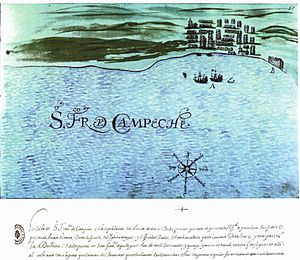Tomás de Cardona facts for kids
Tomás de Cardona was a businessman from Venice who lived in Seville, Spain, in the 1600s. He was well-liked by the Spanish king. Tomás and his partners, Sancho de Meras and Francisco de la Paraya, started a company. Their big idea was to find and collect pearls in California.
They asked the Spanish King, Philip III of Spain, for permission to travel to California. They wanted to use their special ships and tools to collect pearl oysters from deep waters, even 150 to 300 feet down! In 1611, King Philip III gave Tomás de Cardona a special right, called an "encomienda". This allowed him to create a company just for pearl fishing in California. In 1612, he made a deal with the viceroy (a high-ranking official). His company would look for pearls, search for lost ships, and explore California.
Contents
The Big Trip Begins
Tomás de Cardona's company started its work in 1613. They built six ships in Moguer, Spain, and spent a lot of money getting them ready. By the summer of 1613, the ships were prepared to sail to the New World. None of the three main investors went on the trip. Francisco Basilio led the expedition. The second in command was Nicolás de Cardona, Tomás de Cardona's nephew.
Sailing to the New World
The ships left Cádiz, Spain, in July 1613. They sailed with a large fleet led by General Antonio de Oquendo. After crossing the Atlantic Ocean, they sailed among the Caribbean islands. They were looking for "placeres," which are beds of pearl oysters.
Finding Divers
The leaders, Basilio and Nicolás de Cardona, also looked for divers. A rule from 1585 said that Native Americans should not be used for pearl fishing. It said that Black divers should be used instead. Even though this rule wasn't always followed, Black divers were thought to be better at it.
At Margarita Island, some local pearl business owners wanted to use Basilio's ships and tools. Their own divers could only go down about 72 feet. Basilio said no at first. But Spanish officials on Margarita Island ordered him to agree. So, the ships went to the oyster beds, but they didn't find any pearls this time.
Journey to California
From Margarita Island, the company sailed to Vera Cruz in Mexico, arriving in 1614. While they were planning their pearl search in the Gulf of California, Francisco Basilio died. Nicolás de Cardona was chosen to be the new captain. Juan de Iturbe and Pedro Alvarez de Rosales shared command with him.
Building Ships in Acapulco
In the same year, the company traveled across New Spain (Mexico) by land. They set up their main base in Acapulco. They immediately started building three new ships there. By January 1615, three fast ships called frigates were ready. Their names were San Francisco, San Antonio, and San Diego. Building and equipping these ships cost more than 45,000 pesos.
Facing Pirates
Juan de Iturbe's group included soldiers from Mexico City. Before they could sail to California, news reached Acapulco. Dutch pirates, called corsairs, had entered the Pacific Ocean through the Straits of Magellan. They had attacked the coast of Peru and were heading for New Spain.
The main local official, the alcalde mayor, told Iturbe to wait. He ordered Iturbe's men to help get the port ready to defend against the pirates. This work took more than two months. Even though they were helping the king, Iturbe had to pay his men from the company's money during this time. The defense work finished at the end of March. Then, the three ships finally sailed for California with Iturbe in charge.
Later Life
Tomás de Cardona continued to work for the Spanish royal court. In 1622, he became a teacher in the king's chamber. Later, in 1633, King Felipe IV of Spain made a rule that people in charge of money for the king and queen had to show their accounts. In 1634, Tomás Cardona was asked to show his financial records from 1629 to 1633. He was in a difficult situation until he could finally present them later that year.
See also
 In Spanish: Tomás de Cardona para niños
In Spanish: Tomás de Cardona para niños



